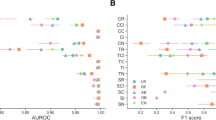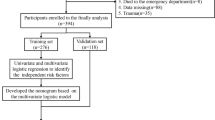Wang W. Cardiovascular health in China: low level vs high diversity. The Lancet Regional Health–Western Pacific. 2020;3. https://doi.org/10.1016/j.lanwpc.2020.100038
Black M, Wang W, Wang W. Ischemic stroke: from next generation sequencing and GWAS to community genomics? OMICS J Integr Biol. 2015;19(8):451–60. https://doi.org/10.1089/omi.2015.0083.
Article
CAS
Google Scholar
Liu D, Zhao Z, Wang A, Ge S, Wang H, Zhang X, et al. Ischemic stroke is associated with the pro-inflammatory potential of N-glycosylated immunoglobulin G. J Neuroinflammation. 2018;15(1):123. https://doi.org/10.1186/s12974-018-1161-1.
Article
CAS
PubMed
PubMed Central
Google Scholar
Zhou M, Wang H, Zeng X, Yin P, Zhu J, Chen W, et al. Mortality, morbidity, and risk factors in China and its provinces, 1990–2017: a systematic analysis for the Global Burden of Disease Study 2017. The Lancet. 2019;394(10204):1145–58. https://doi.org/10.1016/S0140-6736(19)30427-1.
Article
Google Scholar
Wu S, Wu B, Liu M, Chen Z, Wang W, Anderson CS, et al. Stroke in China: advances and challenges in epidemiology, prevention, and management. Lancet Neurol. 2019;18(4):394–405. https://doi.org/10.1016/S1474-4422(18)30500-3.
Article
PubMed
Google Scholar
Park E, Chang H-J, Nam HS. Use of machine learning classifiers and sensor data to detect neurological deficit in stroke patients. J Med Internet Res. 2017;19(4): e120. https://doi.org/10.2196/jmir.7092.
Article
PubMed
PubMed Central
Google Scholar
Shouval R, Fein JA, Savani B, Mohty M, Nagler A. Machine learning and artificial intelligence in haematology. Br J Haematol. 2021;192(2):239–50. https://doi.org/10.1111/bjh.16915.
Article
PubMed
Google Scholar
Wu Y, Fang Y. Stroke Prediction with machine learning methods among older Chinese. Int J Environ Res Public Health. 2020;17(6):1828. https://doi.org/10.3390/ijerph17061828.
Article
PubMed Central
Google Scholar
Wang W, Yan Y, Guo Z, Hou H, Garcia M, Tan X, et al. All around suboptimal health—a joint position paper of the Suboptimal Health Study Consortium and European Association for Predictive, Preventive and Personalised Medicine. EPMA J. 2021;12(4):403–33. https://doi.org/10.1007/s13167-021-00253-2.
Article
PubMed
PubMed Central
Google Scholar
Campbell BC, Mitchell PJ, Kleinig TJ, Dewey HM, Churilov L, Yassi N, et al. Endovascular therapy for ischemic stroke with perfusion-imaging selection. N Engl J Med. 2015;372(11):1009–18. https://doi.org/10.1056/NEJMoa1414792.
Article
CAS
PubMed
Google Scholar
Fisher M, Saver JL. Future directions of acute ischaemic stroke therapy. Lancet Neurol. 2015;14(7):758–67. https://doi.org/10.1016/S1474-4422(15)00054-X.
Article
PubMed
Google Scholar
Ebinger M, Siegerink B, Kunz A, Wendt M, Weber JE, Schwabauer E, et al. Association between dispatch of mobile stroke units and functional outcomes among patients with acute ischemic stroke in Berlin. JAMA. 2021;325(5):454–66. https://doi.org/10.1001/jama.2020.26345.
Article
PubMed
PubMed Central
Google Scholar
Heo J, Yoon JG, Park H, Kim YD, Nam HS, Heo JH. Machine learning–based model for prediction of outcomes in acute stroke. Stroke. 2019;50(5):1263–5. https://doi.org/10.1161/STROKEAHA.118.024293.
Article
PubMed
Google Scholar
Bruffaerts R. Machine learning in neurology: what neurologists can learn from machines and vice versa. J Neurol. 2018;265(11):2745–8. https://doi.org/10.1007/s00415-018-8990-9.
Article
PubMed
Google Scholar
Abedi V, Goyal N, Tsivgoulis G, Hosseinichimeh N, Hontecillas R, Bassaganya-Riera J, et al. Novel screening tool for stroke using artificial neural network. Stroke. 2017;48(6):1678–81. https://doi.org/10.1161/STROKEAHA.117.017033.
Article
PubMed
Google Scholar
Doupe P, Faghmous J, Basu S. Machine learning for health services researchers. Value Health. 2019;22(7):808–15. https://doi.org/10.1016/j.jval.2019.02.012.
Article
PubMed
Google Scholar
Yin T, Zheng H, Ma T, Tian X, Xu J, Li Y, et al. Predicting acupuncture efficacy for functional dyspepsia based on routine clinical features: a machine learning study in the framework of predictive, preventive, and personalized medicine. EPMA J. 2022;13(1):137–47. https://doi.org/10.1007/s13167-022-00271-8.
Article
PubMed
Google Scholar
Polivka J, Pesta M, Rohan V, Celedova L, Mahajani S, Topolcan O, et al. Risks associated with the stroke predisposition at young age: facts and hypotheses in light of individualized predictive and preventive approach. EPMA J. 2019;10(1):81–99. https://doi.org/10.1007/s13167-019-00162-5.
Article
PubMed
PubMed Central
Google Scholar
Gunning D, Stefik M, Choi J, Miller T, Stumpf S, Yang G-Z. XAI—Explainable artificial intelligence. Sci Robot. 2019;4(37):1–3. https://doi.org/10.1126/scirobotics.aay7120.
Article
Google Scholar
Altmann A, Toloşi L, Sander O, Lengauer T. Permutation importance: a corrected feature importance measure. Bioinformatics. 2010;26(10):1340–7. https://doi.org/10.1093/bioinformatics/btq134.
Article
CAS
PubMed
Google Scholar
Pan P, Li Y, **ao Y, Han B, Su L, Su M, et al. Prognostic assessment of COVID-19 in the intensive care unit by machine learning methods: model development and validation. J Med Internet Res. 2020;22(11): e23128. https://doi.org/10.2196/23128.
Article
PubMed
PubMed Central
Google Scholar
Gao S, Wang D. Chinese ischemic stroke subclassification. Front Neurol. 2011;2:6. https://doi.org/10.3389/fneur.2011.00006.
Article
CAS
PubMed
PubMed Central
Google Scholar
OHRP. Regulations, Policy & Guidance: Regulations - 45 CFR 46 HHS.gov: Office for Human Research Protections; 2021 [Available from: https://www.hhs.gov/ohrp/regulations-and-policy/regulations/45-cfr-46/index.html
Rosenfeld A, Graham DG, Jevons S, Ariza J, Hagan D, Wilson A, et al. Development and validation of a risk prediction model to diagnose Barrett’s oesophagus (MARK-BE): a case-control machine learning approach. The Lancet Digital Health. 2020;2(1):e37–48. https://doi.org/10.1016/S2589-7500(19)30216-X.
Article
PubMed
Google Scholar
Kang H. The prevention and handling of the missing data. Korean J Anesthesiol. 2013;64(5):402. https://doi.org/10.4097/kjae.2013.64.5.402.
Article
PubMed
PubMed Central
Google Scholar
Zheng A, Casari A. Feature engineering for machine learning: principles and techniques for data scientists: “O’Reilly Media, Inc.”; 2018.
Li X, Wu M, Sun C, Zhao Z, Wang F, Zheng X, et al. Using machine learning to predict stroke-associated pneumonia in Chinese acute ischaemic stroke patients. Eur J Neurol. 2020;27(8):1656–63. https://doi.org/10.1111/ene.14295.
Article
CAS
PubMed
Google Scholar
Olson RS, La Cava W, Orzechowski P, Urbanowicz RJ, Moore JH. PMLB: a large benchmark suite for machine learning evaluation and comparison. BioData Min. 2017;10(1):1–13. https://doi.org/10.1186/s13040-017-0154-4.
Article
Google Scholar
Chen T, Guestrin C, editors. Xgboost: A scalable tree boosting system. Proceedings of the 22nd acm sigkdd international conference on knowledge discovery and data mining; 2016.
Asaoka R, Hirasawa K, Iwase A, Fu**o Y, Murata H, Shoji N, et al. Validating the usefulness of the “random forests” classifier to diagnose early glaucoma with optical coherence tomography. Am J Ophthalmol. 2017;174:95–103. https://doi.org/10.1016/j.ajo.2016.11.001.
Article
PubMed
Google Scholar
**ao J, Ding R, Xu X, Guan H, Feng X, Sun T, et al. Comparison and development of machine learning tools in the prediction of chronic kidney disease progression. J Transl Med. 2019;17(1):119. https://doi.org/10.1186/s12967-019-1860-0.
Article
PubMed
PubMed Central
Google Scholar
Pernkopf F. Bayesian network classifiers versus selective k-NN classifier. Pattern Recognit. 2005;38(1):1–10. https://doi.org/10.1016/j.patcog.2004.05.012.
Article
Google Scholar
Shamshirgaran SM, Jorm L, Lujic S, Bambrick H. Health related outcomes among people with type 2 diabetes by country of birth: result from the 45 and Up Study. Prim Care Diabetes. 2019;13(1):71–81. https://doi.org/10.1016/j.pcd.2018.08.003.
Article
PubMed
Google Scholar
Demuth HB, Beale MH, De Jess O, Hagan MT. Neural network design. Oklahoma: Martin Hagan; 2nd edition, eBook; 2014. 1012 p.
Nielsen D. Tree boosting with xgboost-why does xgboost win “every” machine learning competition? : Norwegian University of Science and Technology; 2016.
Luo X, Li F, Xu W, Hong K, Yang T, Chen J, et al. Machine learning-based genetic diagnosis models for hereditary hearing loss by the GJB2, SLC26A4 and MT-RNR1 variants. EBioMedicine. 2021;69: 103322. https://doi.org/10.1016/j.ebiom.2021.103322.
Article
CAS
PubMed
PubMed Central
Google Scholar
Murphy KP. Machine learning: a probabilistic perspective. England: The MIT press; 2012. p. 1098.
Google Scholar
Mikhail Korobov KL. Permutation Importance [updated 2017; cited 2021 05 Feb]. Available from: https://eli5.readthedocs.io/en/latest/blackbox/permutation_importance.html
Lundberg SM. shap.TreeExplainer 2018 [Available from: https://shap-lrjball.readthedocs.io/en/docs_update/generated/shap.TreeExplainer.html
Hogan CA, Rajpurkar P, Sowrirajan H, Phillips NA, Le AT, Wu M, et al. Nasopharyngeal metabolomics and machine learning approach for the diagnosis of influenza. EBioMedicine. 2021;71: 103546. https://doi.org/10.1016/j.ebiom.2021.103546.
Article
CAS
PubMed
PubMed Central
Google Scholar
Golubnitschaja O, Baban B, Boniolo G, Wang W, Bubnov R, Kapalla M, et al. Medicine in the early twenty-first century: paradigm and anticipation-EPMA position paper 2016. EPMA J. 2016;7(1):1–13. https://doi.org/10.1186/s13167-016-0072-4.
Article
Google Scholar
Theofilatos K, Korfiati A, Mavroudi S, Cowperthwaite MC, Shpak M. Discovery of stroke-related blood biomarkers from gene expression network models. BMC Med Genomics. 2019;12(1):1–15. https://doi.org/10.1186/s12920-019-0566-8.
Article
CAS
Google Scholar
Martha SR, Cheng Q, Fraser JF, Gong L, Collier LA, Davis SM, et al. Expression of cytokines and chemokines as predictors of stroke outcomes in acute ischemic stroke. Front Neurol. 2020;1391. https://doi.org/10.3389/fneur.2019.01391
Tian Q, Wu S, Wang Y. Overweight and obesity could not predicate all-cause mortality in metabolically healthy individuals. JCI Insight. 2020.https://insight.jci.org/articles/view/136982
Standards of Service Capability of Community Health Service Centres and Township Health Centres. In: China NHCo, editor. https://www.chs.org.cn/news/show/130/: Community Health Association of China; 2018.
Makris K, Haliassos A, Chondrogianni M, Tsivgoulis G. Blood biomarkers in ischemic stroke: potential role and challenges in clinical practice and research. Crit Rev Clin Lab Sci. 2018;55(5):294–328. https://doi.org/10.1080/10408363.2018.1461190.
Article
CAS
PubMed
Google Scholar
Fan L, Gui L, Chai EQ, Wei CJ. Routine hematological parameters are associated with short-and long-term prognosis of patients with ischemic stroke. J Clin Lab Anal. 2018;32(2): e22244. https://doi.org/10.1002/jcla.22244.
Article
CAS
Google Scholar
Hasin Y, Seldin M, Lusis A. Multi-omics approaches to disease. Genome Biol. 2017;18(1):1–15. https://doi.org/10.1186/s13059-017-1215-1.
Article
CAS
Google Scholar
Wang W. Glycomedicine: The current state of the art. Engineering. 2022. https://doi.org/10.1016/j.eng.2022.03.009.
Article
PubMed
Google Scholar
Chen R-L, Balami JS, Esiri MM, Chen L-K, Buchan AM. Ischemic stroke in the elderly: an overview of evidence. Nat Rev Neurol. 2010;6(5):256–65. https://doi.org/10.1038/nrneurol.2010.36.
Article
PubMed
Google Scholar
Koklesova L, Samec M, Liskova A, Zhai K, Büsselberg D, Giordano FA, et al. Mitochondrial impairments in aetiopathology of multifactorial diseases: common origin but individual outcomes in context of 3P medicine. EPMA J. 2021;12(1):27–40. https://doi.org/10.1007/s13167-021-00237-2.
Article
PubMed
PubMed Central
Google Scholar
Koklesova L, Mazurakova A, Samec M, Biringer K, Samuel SM, Büsselberg D, et al. Homocysteine metabolism as the target for predictive medical approach, disease prevention, prognosis, and treatments tailored to the person. EPMA J. 2021;12(4):477–505. https://doi.org/10.1007/s13167-021-00263-0.
Article
PubMed Central
Google Scholar
Zhu B, Pan Y, **g J, Meng X, Zhao X, Liu L, et al. Neutrophil counts, neutrophil ratio, and new stroke in minor ischemic stroke or TIA. Neurology. 2018;90(21):e1870–8. https://doi.org/10.1212/WNL.0000000000005554.
Article
PubMed
Google Scholar
Torres Crigna A, Link B, Samec M, Giordano FA, Kubatka P, Golubnitschaja O. Endothelin-1 axes in the framework of predictive, preventive and personalised (3P) medicine. EPMA J. 2021;12(3):265–305. https://doi.org/10.1007/s13167-021-00248-z.
Article
PubMed Central
Google Scholar
Caine S, Hackett MJ, Hou H, Kumar S, Maley J, Ivanishvili Z, et al. A novel multi-modal platform to image molecular and elemental alterations in ischemic stroke. Neurobiol Dis. 2016;91:132–42. https://doi.org/10.1016/j.nbd.2016.03.006.
Article
CAS
PubMed
Google Scholar
Lee JS, Chang P-Y, Zhang Y, Kizer JR, Best LG, Howard BV. Triglyceride and HDL-C dyslipidemia and risks of coronary heart disease and ischemic stroke by glycemic dysregulation status: the strong heart study. Diabetes Care. 2017;40(4):529–37. https://doi.org/10.2337/dc16-1958.
Article
PubMed
PubMed Central
Google Scholar
Kimberly WT, Wu O, Arsava EM, Garg P, Ji R, Vangel M, et al. Lower hemoglobin correlates with larger stroke volumes in acute ischemic stroke. Cerebrovasc Dis Extra. 2011;1(1):44–53. https://doi.org/10.1159/000328219.
Article
PubMed
PubMed Central
Google Scholar








